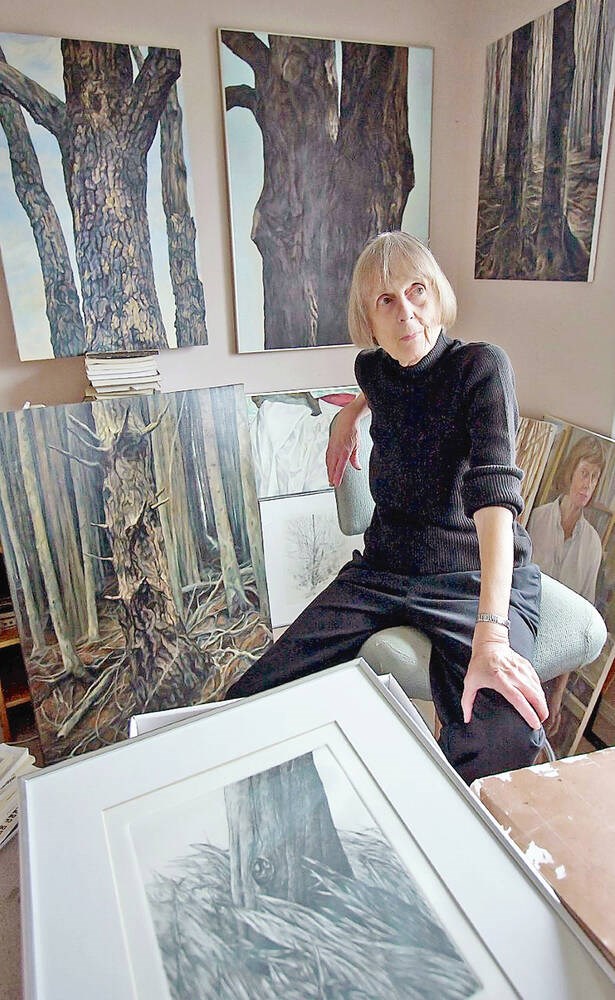My friend Jo Manning, a printmaker of national renown, died on Thursday. It did not come as a surprise, given that before her 98th birthday last month, she booked what she referred to as “assistance.”
Jo had been living in a seniors’ facility across from Beacon Hill Park for a decade or so. She remained active as her health declined, but when her eyes failed, her quality of life fell so far that she believed her best choice was to move on.
She believed in assisted dying, especially after seeing her husband suffer in his final months. Besides, she had set her own course for most of her life, so choosing the date of her death made sense.
We met several years ago through a mutual friend with an interest in art. I got to know her through visits as well as her witty, cogent and pointed letters to the editor, about everything from the joy of spring to the hazards that pedestrians faced because of drivers.
Jo was born in Sidney on Dec. 10, 1923, the daughter of Dr. Frederick William Manning and his wife, the former Elizabeth Wilcox, but spent most of her life in Ontario.
For her 90th birthday, I helped her reconnect with her local roots in a small way, taking her to see the house at 821 Linden Street, where Rev. W. Leslie Clay of St. Andrews Presbyterian Church had lived. That was where Manning’s parents were married on July 23, 1921.
In one of her books, Manning described her childhood in a house next to the water in Sidney. She remembered the wonder of seas and trees. She remembered searching for wildflowers in the meadow grass, and for sea anemones hidden in rock crevices.
“I’m an old woman now, but I remember sitting in tall grass when I was very small. I remember so clearly looking up into its sunny green spears and at my big black dog.”
The family moved to Ontario when Jo was five. She developed an interest in art and graduated with honours from the Ontario College of Art. She married botanist Klaus Rothfels and raised four children — Paul, Peter, Ann and Mary — but her interest in art did not fade away.
In her late 30s she returned to the college as a part-time student and learned about printmaking. Her first etching was of grass. She soon became known for her exquisitely detailed prints of everyday items — grass, trees, fenceposts and even shirts.
Her first show was with two other artists in Toronto’s central library in 1965. After that she took part in dozens of exhibitions in Canada, as well as in Germany, Chile, Yugoslavia, France, Belgium, Italy and Poland. Manning won first prize in the fourth American Print Biennale in Santiago, Chile, in 1970.
Her works are in collections such as the National Gallery of Canada, the National Library of Canada, the Canada Council Art Bank, the Montreal Museum of Fine Arts and the University of Victoria.
Manning stopped making prints in the early 1980s, turning to watercolours, oils and drawing.
After moving to Victoria in 1997 with her second husband, Al Beecroft, Jo found inspiration for her work in Beacon Hill Park and in James Bay. She also wrote two books on her life and several short stories.
Her husband Al died in January 2012.
In October that year, after we published a commentary by Dr. Chris Pengilly in support of assisted dying, Jo wrote about the way Al had suffered.
“During the last few months of my husband’s life, he desperately wanted to die,” she said. “After a second bout of pneumonia, he screamed from his wheelchair: ‘Kill me, kill me,’ over and over. I said it was against the law. He said: ‘[expletive] the law.’
“He was in torment but his heart kept beating, his body would not let him go.
“Later, when he was dying after the third attack, I sat with him for a few hours. He held my hand and looked at me in contentment. ‘I’m going,’ he said.
“Dr. Chris Pengilly pleads for a better way. Please.”
Four years later, after the assisted dying bill was sent to the Senate, she wrote again.
“It seems difficult for those in Ottawa to agree on a fair policy. The debaters are still in their active years and most are far from their dying.
“We, the old, should be in the conversation. We have watched our mates and our friends die; sometimes it is a hard passage that breaks the heart.
“My husband suffered for months before he could welcome his end. He begged to die many times.
“We now have the means to ease the final, inevitable passage. Surely it should not be so hard for Ottawa to come to a wise decision?”
After the law was changed, Jo expressed relief, knowing that she would be able to avoid the fate of Al and many of her friends.
She remained feisty, witty and highly opinionated to the end. No surprise there, given the struggles she had faced as a young woman trying to break into the male-dominated art community.
Hers was a long life, and a full life, one with many highs and lows. As she often said, “whatever happens, it could always be worse.”
I saw her for the last time in December. With pandemic restrictions, I could not visit her again, but I phoned on Wednesday for one last conversation.
We reminisced for a few minutes. She told me I should retire so I would have more time for the historical research that I love. And then, for the last time, she said goodbye.
Dave Obee is editor and publisher of the Times Colonist.



